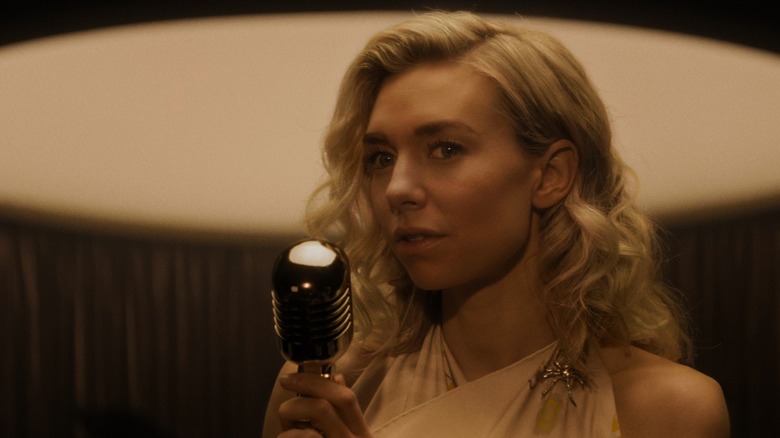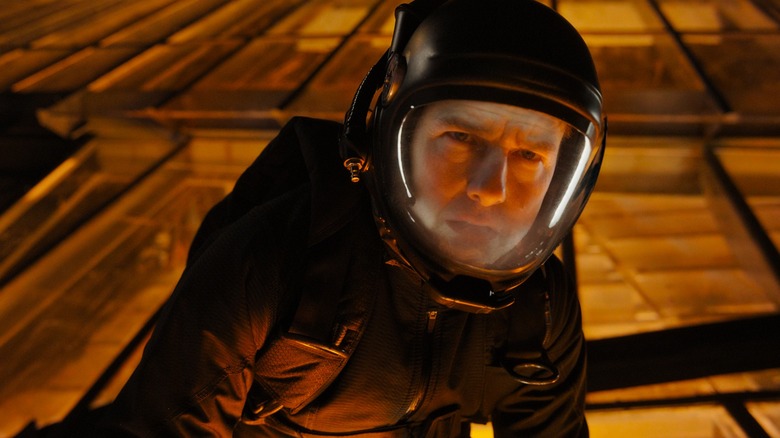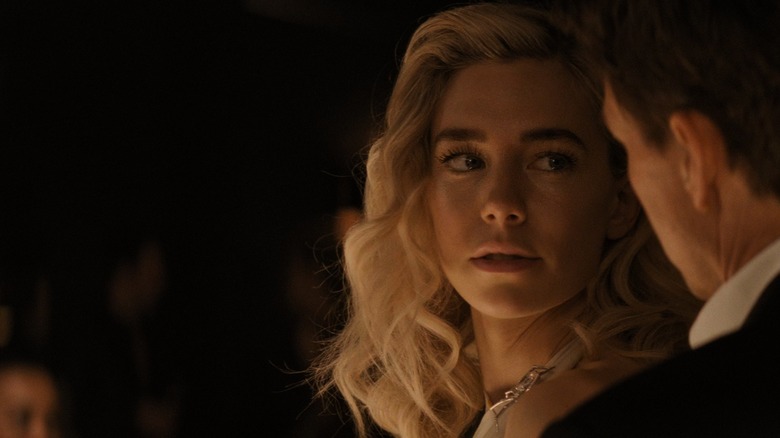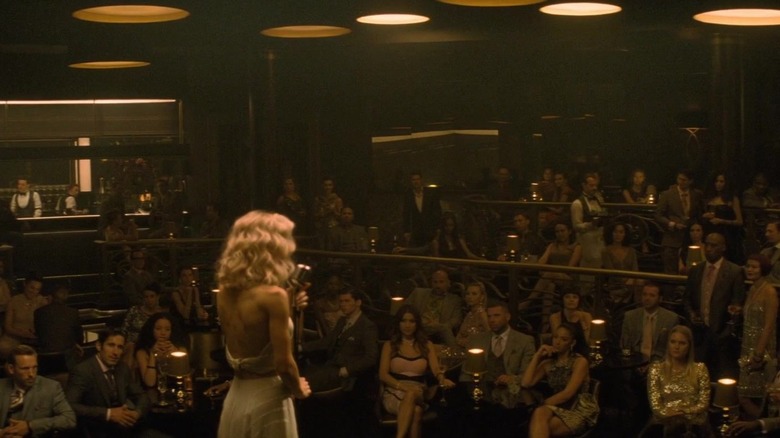Mission: Impossible - Fallout Cut A Fully-Filmed Vanessa Kirby Musical Number
After taking over the reins of the "Mission: Impossible" franchise, director Chris McQuarrie quickly put his own stamp on the series. From 2015's "Mission: Impossible – Rogue Nation" to 2023's "Dead Reckoning Part One," McQuarrie's take on the series has brought it back to its roots in creating heightened, suspenseful espionage scenarios. It's also made the movies even bigger.
The stunts of Ethan Hunt (Tom Cruise, doing them all himself as shown in much-hyped pre-release marketing) are one aspect in which the series has to consistently top itself. But for McQuarrie, it's also important that each movie embraces a different kind of spectacular filmmaking, something spontaneous and creative that goes beyond simple James Bond-esque globetrotting gunfights and car chases. Because of that impulse, he might have gone too far with a scene in 2018's "Mission: Impossible – Fallout," which is probably why it didn't make the final cut.
The scene in question would have involved the introduction of Alanna Mitsopolis (Vanessa Kirby), or the White Widow, a glamorous arms dealer. With Hunt and his IMF squadmates working to prevent her from brokering a plutonium deal with terrorists, she would introduce herself with a song. Complete with a musical number and an orchestra, according to Collider.
It would have been an appropriately fabulous and seductive entrance for the femme fatale, but for McQuarrie, the scene became a darling in need of killing. With the movie's test cut running close to three hours, he had to be ruthless in consigning material to the cutting room floor.
Stunts
While co-writer and director Chris McQuarrie's run on the series has seen progressively longer entries, topping out at "Dead Reckoning Part One" with a nearly three-hour runtime, his precise filmmaking and keen editorial eye ensure the experiences fly by. The White Widow's musical number, while an exciting enough idea to warrant actually getting written, choreographed, orchestrated, and shot, ultimately stopped the action of the film dead in its place.
The reason McQuarrie's films are so effective in their pacing is because of their almost single-minded focus on a one-sentence plot hook. For "Mission: Impossible – Fallout," that all comes down to Ethan needing to find stolen plutonium. Every line and character beat emerges naturally from that plot, which is also true of the hooks for "Rogue Nation" and "Dead Reckoning." And that basic plot feeds into the real meat of the series, which is of course whatever cool things McQuarrie and star Tom Cruise can devise for Ethan to do.
With "Fallout" that led to a handful of setpieces, like the 25,000-foot HALO jump that became the movie's signature scene. While the jump's narrative purpose is to get Ethan and antagonistic CIA assassin August Walker (Henry Cavill) into a Parisian nightclub, it's more important for how thrilling it is. The Parisian nightclub is the site of the Widow's plutonium deal. This is where she was to be introduced with a song, an atypical kind of setpiece for the series.
A femme fatale introduction
As Ethan and agent Ilsa Faust (Rebecca Ferguson) enter the room from different sides, suspiciously eying every potential threat in the crowd, they hear Alanna discussing her charitable endeavors and her mother. While the close-ups of Alanna isolate actress Vanessa Kirby delivering the speech, the shots of her and the crowd tell a different story, and eagle-eyed viewers might notice. Kirby is shot from behind, and her speech looks a lot like she might be singing. Those shots were a relic of the original cut with the musical number.
It's no secret that Chris McQuarrie loves to draw from classic Hollywood for his "Mission: Impossible" movies, taking the classic thrilling ingredients of Buster Keaton stunts and Alfred Hitchcock suspense sequences to build something new. As he told Collider, "the White Widow was singing when you first walked into the room with her," which would have alluded to another classic Hollywood trope: the femme fatale musical number, a staple in film noir.
In 1946's "The Big Sleep," Lauren Bacall sang "And Her Tears Flowed Like Wine" at a nightclub just before the movie's most tense and loaded bit of flirtation between her and Humphrey Bogart. The same year's Rita Hayworth vehicle "Gilda" paused the action for two overdubbed numbers, "Put the Blame on Mame" and "Amado Mio," and the 1952 spiritual sequel "Affair in Trinidad" did the same with different songs.
In the essay "Film Noir and The Musical Woman," Adrienne L. McLean claims these scenes in classic films get "dismissed as moments where nothing during which nothing important happens." Such mood-building, performance-oriented scenes feel worlds apart from the heavy plotting of modern films. For as much as McQuarrie's "Mission: Impossible" films draw from classic Hollywood, they ultimately end up on the "heavy plotting" side of things.
Cuts and cuts
It wasn't until the movie's testing phase that Chris McQuarrie began to realize that the musical number paused the action too significantly. Originally, the premise he had developed with cinematographer Rob Hardy was to establish the difference between the nightclub and the White Widow's domain. As he recalled to Collider, the idea was a flash of inspiration: "Oh my God, she could be singing!" Vanessa Kirby learned the song, practiced it, and an orchestra was brought in to complete it. The hope was that the scene would set the mood, and establish Alanna as a different kind of morally gray character.
But the movie had gotten long. At 2 hours and 43 minutes, it was a film in need of trimming, and McQuarrie noticed that when the movie was screened for audiences, the scene stopped things dead. As editor Eddie Hamilton noted, the movie doesn't really start in earnest until terrorist leader Solomon Lane (Sean Harris) enters the picture, and every moment before then needs to justify itself. For all the inspiration and work that went into the musical number, it ultimately defeated its own purpose, deflating the tension of the scene and making the movie run a little long.
In many ways, "Mission: Impossible – Fallout" is the best-edited movie of the series, building up its plot with a cool, elegant sense of momentum that only gets better with every big action scene. It set a new standard for action filmmaking. Even at its eventual runtime of 2 hours and 27 minutes, just sixteen minutes shorter than the test cut, it flies by. But you can still see glimpses of the musical number that got cut.



